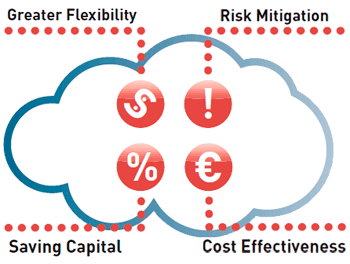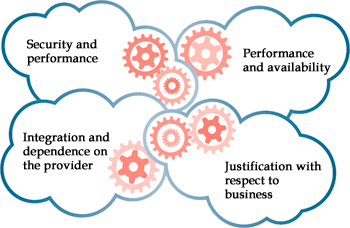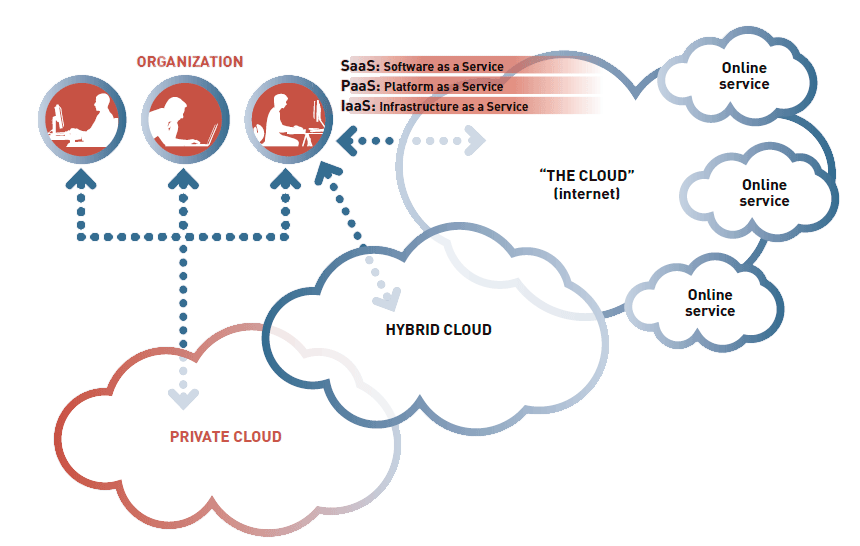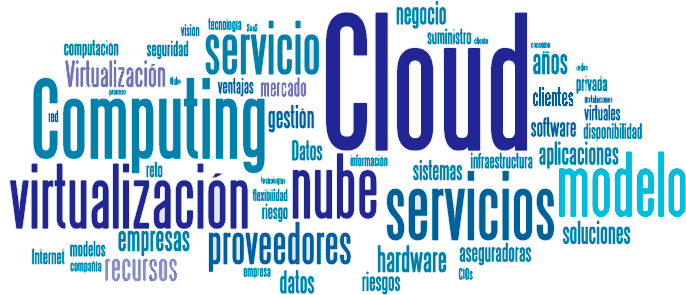Interview with Enrique Riesgo. Head of Innovation and Solutions at CSC Madrid - SpainTechnical
Enrique Riesgo is an IT Manager and Architect specialised in distributed systems and systems integration using SOA and Cloud Computing technologies. He has over 10 years international experience in consultancy, systems integration and outsourcing of services for multinationals from a wide variety of sectors, including banking and insurance.





“Cloud Computing is the greatest change to have come about in recent times in the world of Information Technology”
In the world of Chief Information Officers (CIO), Cloud Computing is a daily handled term. The resounding advantages it has to offer regarding saving, flexibility and efficiency, counteract all new challenges arisen by doubts with regard to security, availability and trust. Enrique Riesgo, Head of Innovation and Solutions at CSC, explains how still today, the private cloud has more supporters than the shared cloud. He analyses the current relationship between Cloud and Virtualization and reviews the impact on the Environment, showing a promising outlook for new technologies as a service for the financial and insurance sector as well as a labour niche for IT professionals to be trained in Cloud environment.
When was Cloud Computing created?
Curiously, the idea dates back to the sixties when it was considered that possibly, one day, the capacity for computing could be organised and delivered as a public service, in the same way as that provided by the electricity, water or gas utilities. It was not until the end of the last decade that the development and popularity of technologies such as virtualization, Internet, Utility Computing and service orientated architecture (SOA), had produced the necessary conditions for converting the idea into a reality.
The name Cloud Computing embraces the idea of the provision of computing services from the cloud which is nothing more than a metaphor for Internet
The name Cloud Computing portrays the idea of providing computing services from a Cloud, which is no more than a metaphor for the Internet; something abstract, the technical details of which are of no interest.
By way of an anecdote, it is worth mentioning that it is generally accepted that it was Google that first used the term Cloud Computing in this sense, back in 2006.
What is Cloud Computing?
Perhaps the analogue most used to explain what Cloud Computing consists of is that of electricity supply. We all know exactly how it works: we contract the service through an electricity company, we have practically an unlimited supply available, we pay per use and we are not really interested where the power comes from. We know that there is a risk of failure of supply, so we adopt remedies depending on our needs (from having a torch in our home to a generator in a hospital). However, for operational, financial and practical reasons, very few people consider the possibility of having their own power sources.
Google was the first to use the term Cloud Computing in 2006
So, we should imagine computing resources (computing time, memory, storage, software) as if they were electricity; Internet would be the grid and the Cloud would be the electricity company with infrastructures, staff and procedures which are unknown to us but which we trust.
The Cloud Computing model has five fundamental characteristics which differentiate it from other models or technologies such as virtualization or Utility Computing. These are: on demand self service capacity, “broad” access through the Internet, the existence of a shared resource fund, rapid elasticity and measurement of the service consumption.
Traditionally, it is divided into four categories as shown in the following diagram:
- Business Process as a Service (PaaS)
- Software as a Service (SaaS) Applications used by subscription Parameterizable
- Platform as a Service (PaaS) A development platform that abstracts infrastructure, operative systems and middleware.
- Infrastructure as a Service (IaaS) A Platform that abstracts the infrastructure
Advantages: What is causing the growth in the Cloud?

Greater Flexibility
- Accelerating cycles.
- Adapting IT resources to demand.
- Relieving IT limitations.
- Breaking down IT barriers to create new products.
Risk Mitigation
- Meeting performance and availability requirements.
- Mitigating risk and improving the return from new projects.
- Starting without investment in IT or waiting times.
Saving Capital
- Freeing up capital.
- Changing capital expenditure (CAPEX) into operational expenditure (OPEX) in order to improve the return.
- Managing IT expansion and containing the infrastructure.
Cost Effectiveness
- Aligning business and infrastructure.
- Using what is needed only when necessary.
- Focusing IT personnel on adding value to the company.
- Integrating physical, virtual and cloud infrastructures.
What are the possible risks that have been identified to date?
Unfortunately, using Cloud Computing at the moment is not simple and there are four typical risks that need to be analysed, evaluated and subsequently, mitigated.
The first, and most common, is security. This is mainly focused on data privacy that is outside the limits of the organization and compliance with current legislation, especially the Law on Data Protection (LODP1). Who can see my data? Who is protecting my data? Can these be lost? This is a very relevant service aspect and Cloud providers dedicate great efforts to care for the security and integrity of their clients´ information.
Service availability is the second risk. The impact on the business of failure of a technological service can have serious consequences. Service providers normally set up service levels to guarantee its availability within certain margins that can reach 99.95% in operational time.
Other typical risks can be the difficulties of integrating the systems deployed in one´s installations into those of the cloud, the need to standardise certain processes and the lack of professionals that are qualified in the implementation and management of Cloud environments.
The Cloud Computing model has five fundamental characteristics: on demand self service capacity, “broad” access through the Internet, and the existence of a shared resource, rapid elasticity and measurement of the service consumption
Something that often causes confusion when talking about Virtualization and Cloud is: can virtualization be considered to form part of Cloud Computing or is it complementary to Cloud Computing?
There is a close relationship between the two of them.
Virtualization is a mechanism that allows us to have at our disposal a real IT resource with different versions. The simplest example would be a hard disk with a specific physical size (e.g. 1 Terabyte) that can be converted, through virtualization, into as many disks and sizes as we like, but with the properties of the actual disc. Virtualization enables us to take better advantage of the resources at our disposal.
In the case of Cloud Computing, virtualization has enabled service providers in the cloud to optimize their physical resources (computers, disks, networks) and to define new business models through which they offer virtualized resources as a service. For example, storage, virtual machines, virtual desks, etc. In other words, virtualization can be considered to be a key enabler for the Cloud Computing model.
Moreover, some companies decide to contract certain services through the Cloud Computing model and to virtualize the infrastructure that they use for their installations. The basic difference is the financial model: payment for usage (Cloud) as opposed to investment (virtualization).
Challenges for the adoption of cloud computing

Security and performance
- Where are my data?
- Who can see my data?
- Who has seen my data?
- Are they protected?
Performance and availability
- Where is this process carried out?
- What happens to my SLA*?
- Are back-ups being made?
- How can I maintain the chain of responsibilities?
Integration and dependence on the provider
- Is interoperability possible?
- Are there any standards?
- What platform should be used?
- What service metrics should I use?
Justification with respect to business
- Do I have to convert applications?
- Is the executive team prepared?
- What is the ROI?
- What do I have to do first?
*Service Level Agreements
Once the Virtualization concept has been grasped, could it be said that it affects both the field of software as well as hardware? Could there be some examples that enable us to differentiate when talking about Virtualization hardware or Virtualization software?
Of course, there are. The IT resources that we are talking about include both software and hardware.
The beforementioned example is a very simple case of hardware virtualization, in which a hard drive (disc) appears as several virtual drives. Other popular examples of hardware virtualization are virtual machines that operate as if they were a virtual computer with an operating system, network virtualization and memory virtualization.
As far as software virtualization is concerned, perhaps the most popular is the virtualization of applications which allows us to dissociate them from the operating system, the best known exponent of which is Citrix.
Virtualization is a mechanism that allows us to have at our disposal a real IT resource with different versions.
Virtualization of systems is a very trendy topic but, as far as management tools are concerned, how developed are they?
Regarding hardware virtualization, most of the work has been done. Management tools have been in the market for many years and are well developed. For this reason, perhaps the greatest challenge is the application of good practices and suitable management processes.
In the field of applications, there are great pioneers such as the CRM Salesforce which has been serving its clients for many years with this model and other applications which have recently been seen to adopt the Cloud model.
What do you consider to be the most positive aspects associated with Cloud?
From the business point of view, we think that there are mainly four.
- The first is flexibility. The possibility of having the technological resources available at any time, and almost immediately, represents an important advance and has a direct impact on one´s business cycles, which can be substantially shortened.
- The second positive aspect is capital saving. In the current climate with such restricted credit, the availability of an instrument that allows you to innovate without investing or getting into debt is a very valuable tool for any company
- The third point is the efficiency obtained thanks to the elasticity that Cloud Computing offers for budgeting and consuming only those resources required at a given time. In this way, it is possible to adjust the available resources more exactly to the business needs and to avoid having to keep resources available in case of peeks in demand or future growth.
- Lastly, there is risk reduction, closely related to the previous points, and which is achieved by putting together all these aspects and the consequent improvement in the return on investment.
It is much quicker, requires less investment, is more efficient and with less risk to contract electricity supply, change the amount of power when required and eventually end the contract, than to build and maintain one´s own thermal power station or solar power farm.
Cloud Computing is being talked about in the Technology Forums. Could it be said that it is the new IT model? In the cloud, should we take Applications and Data Processing Centers into consideration?
Definitely. Not only it is a new model but, in my opinion, Cloud Computing is the greatest change that has come about in IT (Information Technology) in recent years. It represents an authentic revolution in the way things are done, in the way in which technology is understood, the relationship between suppliers and consumers and, above all, in the business models that surround IT.
To answer the second question, yes. The first are those applications that can be used on demand, paying only according to what we use; this model is called SaaS, software as a service. The second are data centers that service providers in the cloud use to offer their services.
Models of service and deployment models

Private cloud or shared cloud: what are the reasons for which a company should choose one or the other?
As a general rule, a private cloud should be the first option for those organisations that have stricter requirements in respect of security, performance and legal compliance. The disadvantage is that private clouds hardly help to achieve any of the four advantages mentioned before. Their start-up is slow, they require a heavy investment and many resources are wasted.
On the other hand, the shared cloud, which is generally public, provides unlimited access to all the advantages of cloud computing, especially the financial and flexibility advantages. However, the associated risks and dangers must be analysed and mitigated. Nevertheless, not everything is black and white and it is not necessary to adopt exclusively one single model. In fact, at CSC we think that the hybrid cloud is the model that will be most widely adopted in the future since it takes the best of both worlds by combining the public and private clouds in a transparent and efficient manner.
In the current economic climate, what should IT managers in large and medium sized companies be backing? What are Chief Information Officers talking about?
With the current debt crisis and credit restrictions, the public cloud presents an excellent opportunity to continue innovating and creating value with minimum risk and without the need to get into debt. Nevertheless, for security and confidence reasons, CIOs still prefer the private cloud as opposed to services through the public cloud, despite the limited financial advantages. For this reason, we for example, have launched a unique private cloud service with payment for usage which combines the best of both worlds and is enjoying an excellent reception from the CIOs.
In a recent survey of CIOs in European companies, 37% identified the use of Cloud Computing to be important or very important in the forthcoming years.

Are there statistics or measurements of the acceptance level of Cloud in medium sized and large companies? How is the current economic crisis affecting this new technology?
Naturally, there are many, both for the global and national market. For example, Forrester Research2 indicated that last year, the introduction of the different service models (SaaS, PaaS and IaaS) was between 25% and 10% in the large American and European companies. Regarding Spain, Penteo Analyst3 presented similar numbers in a study carried out in April in which they indicated that 60% of companies with a turnover in excess of 500 million EUR, were using some form of Cloud service. Anyway, these studies only show the number of companies that make use of some type of service in the cloud but not what percentage uses cloud services as opposed to the traditional model.
Regarding evolution, the same studies show projections on the market progression over the next few years with growth rates which are always far greater than that of the traditional IT market. The current crisis simply favours the implementation of cloud since its financial advantages are undeniable.
When a company offers Cloud services to a large company, the latter is depositing all of its information in the hands of a third party, without real sight of the supporting infrastructures and the means of guaranteeing business continuity in the event of loss. How are insurance companies participating? Are there any applicable regulatory norms? Are there any covers in the market that could be applied?
It is important that clients have a vision of the situation and working of everything contracted via the Cloud Computing model. At CSC we aim to provide our clients with this vision and for this reason, we have developed the Cloud Trust Protocol to enable the integration of different suppliers´ information and, in this way, to offer transparent and reliable management of this kind of service.
Nevertheless, it is true that there are risks which are similar to those borne by companies when they have their systems in the traditional format but, in this case, they reside in the hands of third parties. This is an area in which insurers are not participating but Cloud insure (www.Cloudinsure.com) is an American company that has recently been set up to fill this gap. There is still a business opportunity for the sector.
Could you provide some examples of where these new solutions have been efficiently introduced in the world of Finance and / or Insurance?
There are various examples. Several insurers use these kinds of solutions for the management of agent and client relations. Amongst them is one of the largest European insurers for its UK business. The advantages obtained in this regard are greater flexibility (with regard to variations in the sales network), the almost immediate availability of new mobility and sales channels which are reflected in improved client response.
In the area of supplier relations, some insurers also have opted for these types of solution to improve the purchasing process. This improvement, which in many cases involves strong consolidation, gives rise to interesting cost savings and the possibility of better supplier and purchaser evaluations.
In banking, moreover, infrastructure solutions as a service are being used successfully. One of the large Spanish banks executes simulation processes contracted with the Cloud model for calculating credit risks and has drastically reduced the execution time and cost.
The same is true of a credit card issuing company that decided to execute its analysis processes for client transaction information on infrastructure contracted as a service and, in this way, managed to reduce the execution time and cost. This is a process that traditionally has taken days and can now be executed in thirteen minutes.
There is also a lot of talk about the environmental commitment. Can it be said that both Virtualization and Cloud Computing are designed to achieve this?
Of course. Firstly, because both Cloud and virtualization aim to improve the exploitation of natural resources and therefore, improve aspects such as the use of industrial land or energy consumption and the carbon footprint.
Both Cloud and virtualization aim to improve the utilization of physical resources and, therefore, improve aspects such as the use of industrial land or energy consumption and the carbon footprint
Moreover, since the large providers of Cloud Computing services are committed to the environment, they recognise that to be efficient is not enough. Some of the large data centres, which require a higher power consumption, are setting up in places where renewable energies are available with a view to improving the impact on the environment.
To conclude the analysis of Virtualization and Cloud Computing, could we say that IT Managers have an important challenge over the next few years in having to adapt their systems to these new trends?
Exactly. That is the challenge. Everyone is talking about Cloud and many suppliers are offering Cloud solutions but not many are explaining how to transform the services provided by the existing IT Department into a Cloud environment. Everyone proposes Cloud as a catalogue of new solutions to be acquired but almost no one suggests that it is a tool to transform existing services.
For those who have already adopted some of this model´s services, the next challenge is to construct a control model that will enable them to manage these services in a way which integrates them into the company´s IT.
For additional information:
1 Only applicable to Spain
2 http://www.forrester.com/ itprofessional
3 http://www.penteo.com



